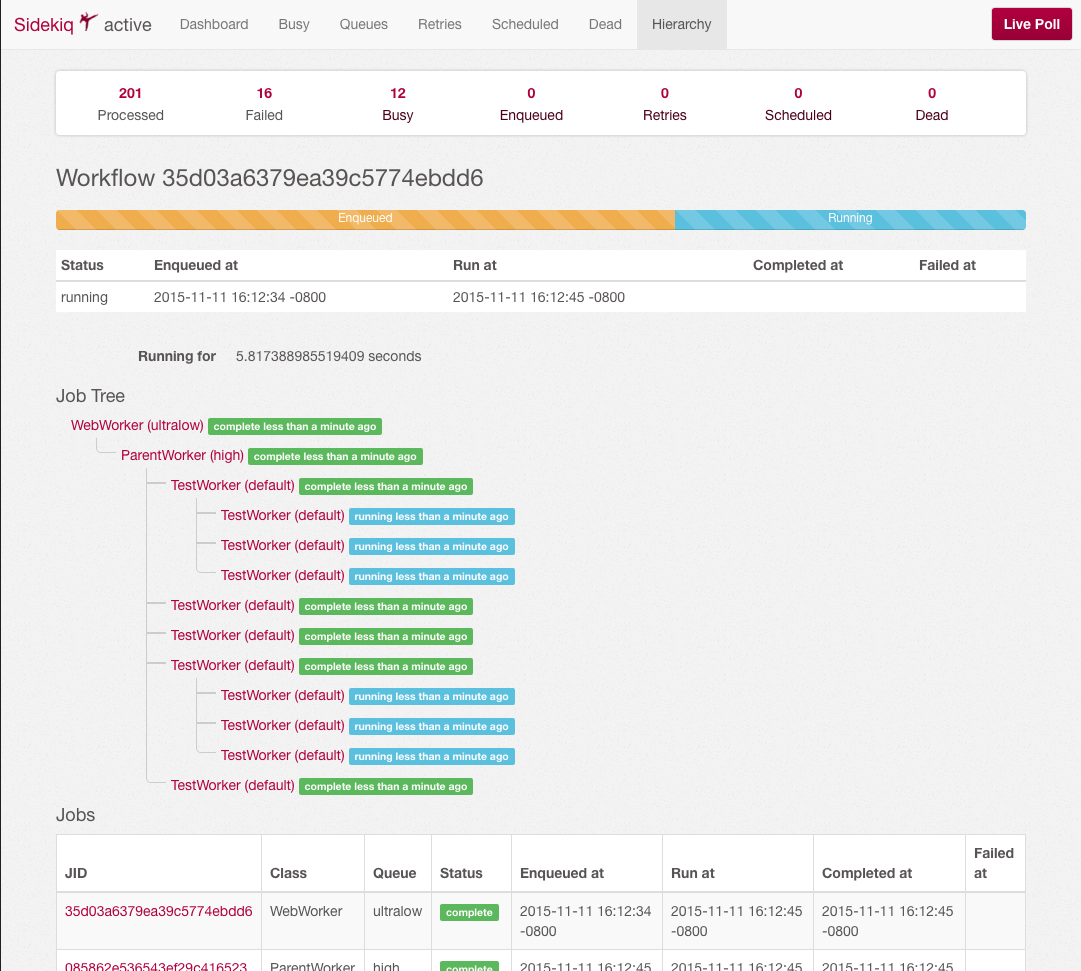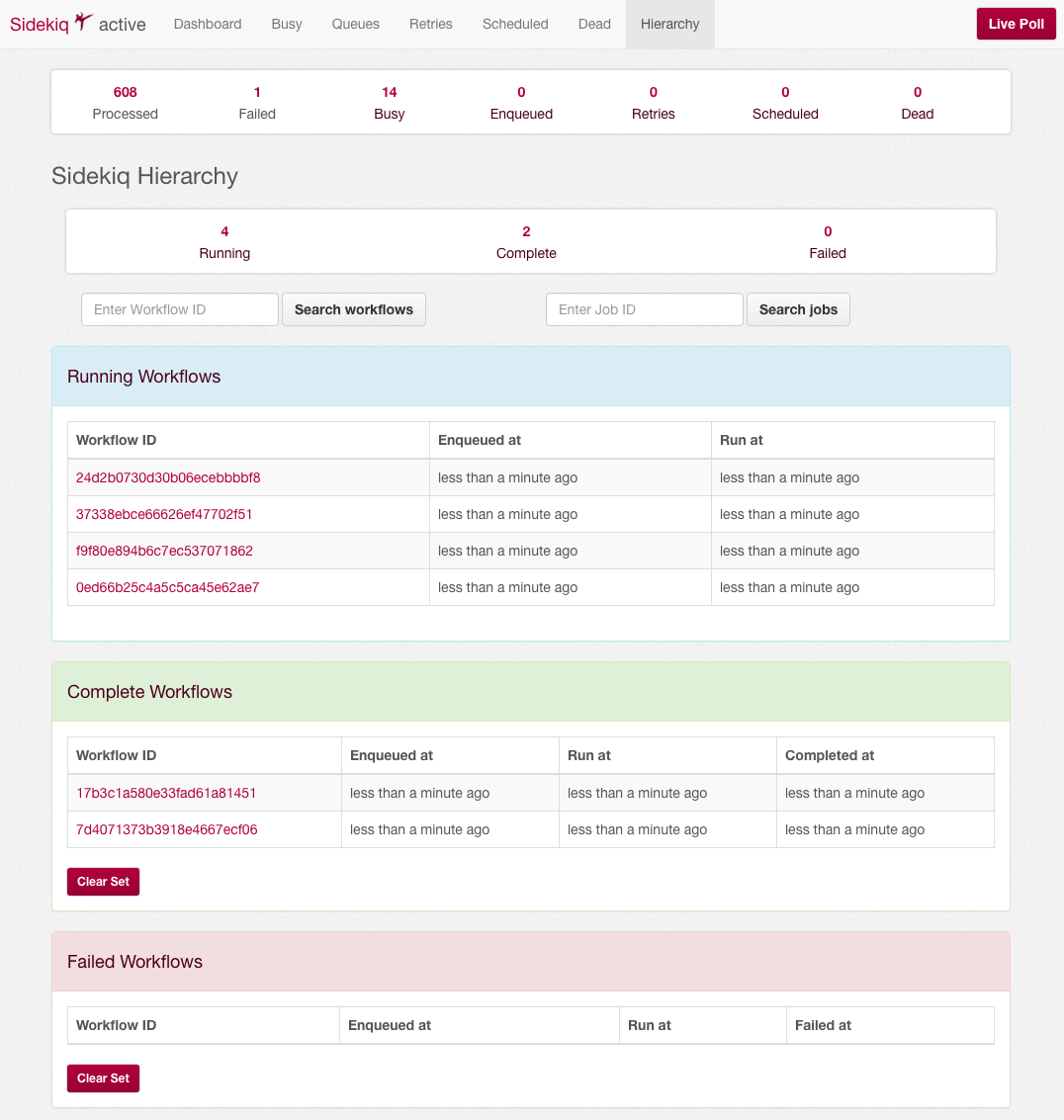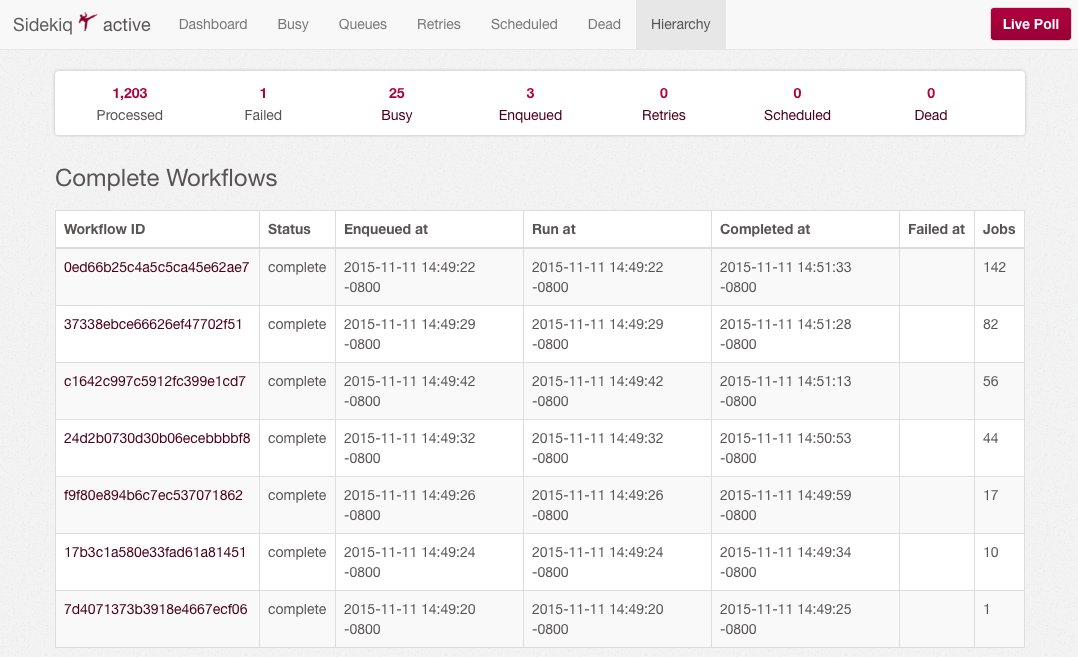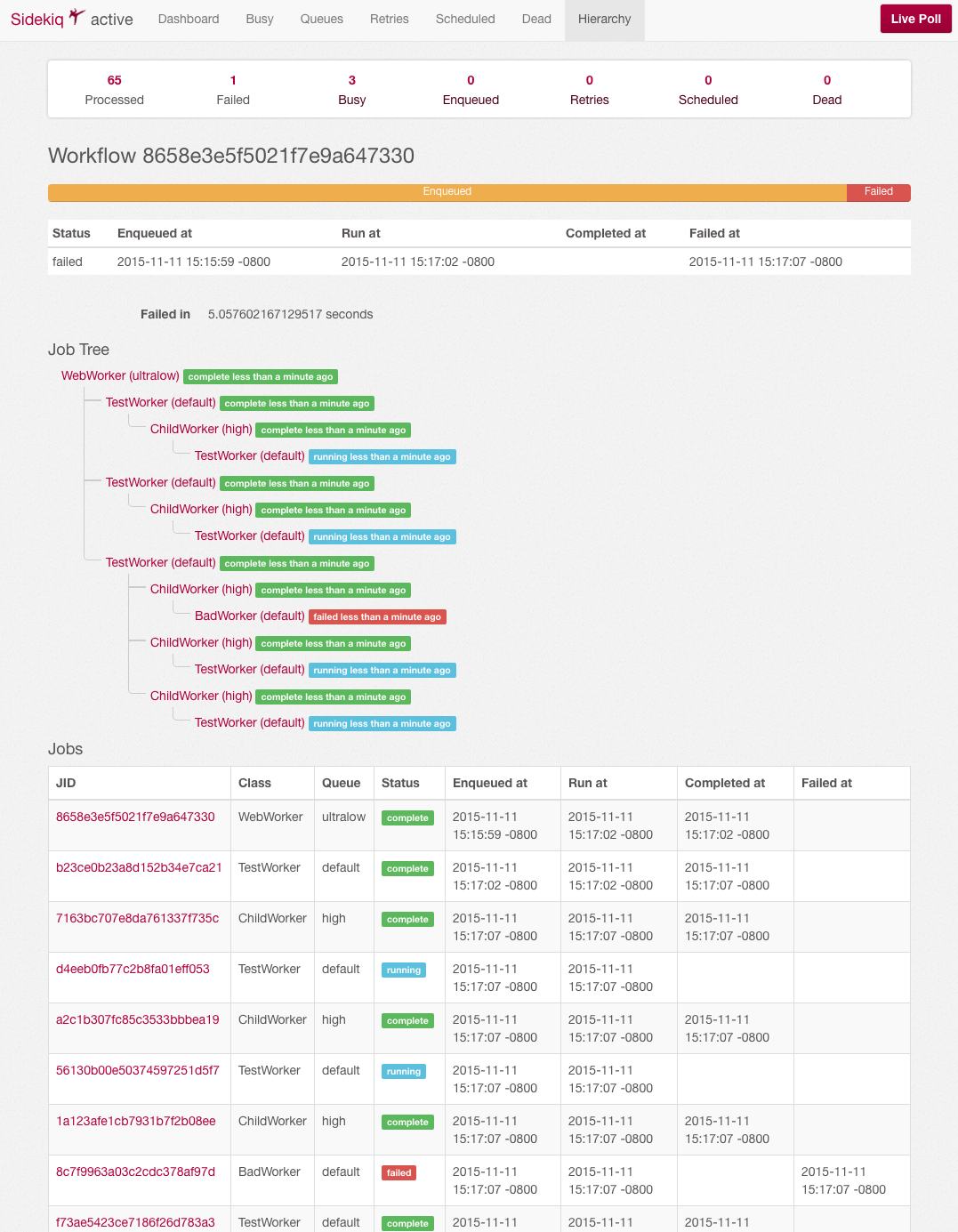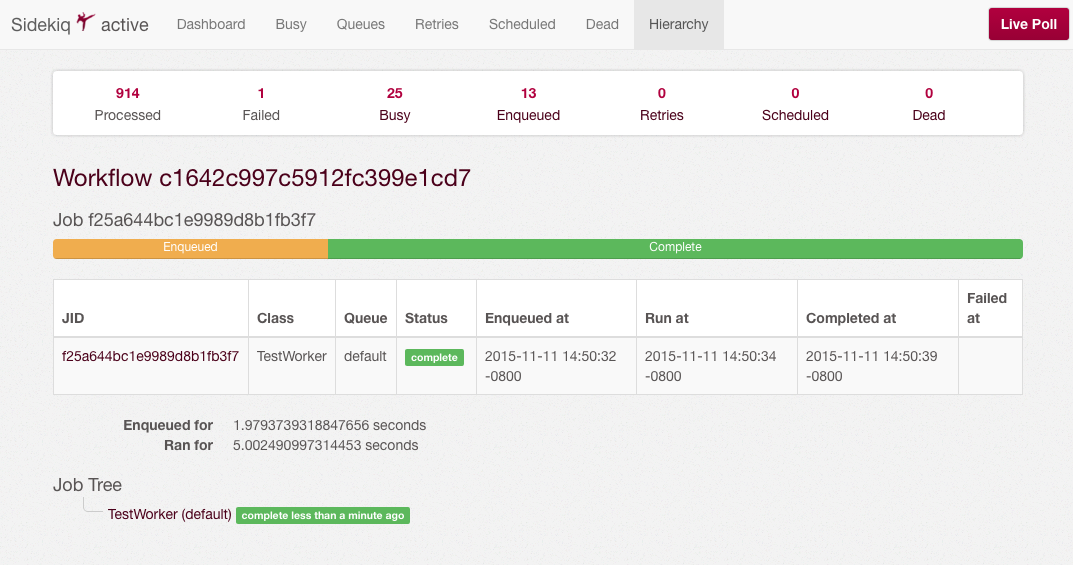Sidekiq-hierarchy is a gem that implements parent-child hierarchies between sidekiq jobs. Via several middlewares, it allows tracking complete workflows of multiple levels of sidekiq jobs, even across network calls, so long as a shared redis host is available.
You may want to use sidekiq-hierarchy if you:
- have complex (or simple) hierarchies of jobs triggering other jobs
- want to understand timing breakdowns (enqueued, run, and completed times) per job and per workflow
- are investigating how job requeues and retries impact your runtimes, e.g., to maintain SLAs
- would like to perform actions on job and workflow status changes via callbacks, for instance providing progress feedback or statistical trend data
- need to pass arbitrary data between parent and child jobs, in order to implement, e.g., prioritized workflows, or fail-fast workflows
- trigger jobs via network calls and want insight into the call graphs
Disclaimer: Sidekiq-hierarchy supports Sidekiq 3.x, and thus MRI 2.0+ and JRuby; it may work on MRI 1.9, but this configuration is untested as Sidekiq's unit testing support does not extend to it.
Sidekiq-hierarchy is designed to be as unobtrusive as possible. The simplest possible use case, in which jobs trigger other jobs directly (via #perform_async), can be realized via a few lines of code. First, set up Sidekiq and make sure that the gem is installed (see Installation, below). Then:
- Add the Sidekiq middlewares to your global Sidekiq configuration, usually in an initializer (e.g.,
config/initializers/sidekiq.rb):
Sidekiq.configure_client do |config|
config.client_middleware do |chain|
chain.add Sidekiq::Hierarchy::Client::Middleware
end
end
Sidekiq.configure_server do |config|
config.client_middleware do |chain|
chain.add Sidekiq::Hierarchy::Client::Middleware
end
config.server_middleware do |chain|
chain.add Sidekiq::Hierarchy::Server::Middleware
end
endNote that the Client middleware must be added to both the server and client configs.
Since instrumentation occurs in these middlewares, other middlewares you write that make use of Sidekiq-hierarchy's capabilities must be nested appropriately (inside or outside, depending on whether they make use of workflow data-passing or they modify queuing behaviour).
- Mark your workflow entry points, the jobs that are the root nodes of your work trees. Only the roots need to be modified: any children (or children or children, etc.) will automatically inherit the setting (though it won't hurt if you add them too). Simply append to the sidekiq_options in the worker class:
class RootWorker
include Sidekiq::Worker
sidekiq_options workflow: true
# def perform(*args)
# 5.times do |n|
# ChildWorker.perform_async(n, *args)
# end
# endThe main concern is Redis storage space: if you are fine instrumenting all jobs (because your Redis instance is huge, or your job throughput is not very high, or you're debugging), you can set this in your global options:
Sidekiq.default_worker_options = { 'workflow' => true }You're done! Any new instances of your root worker will now record their child hierarchies.
Some examples to try, given a root JID:
# > root_jid = RootWorker.perform_async
# => "11c3ec3df251ebb646f910d7"
> workflow = Sidekiq::Hierarchy::Workflow.find_by_jid(root_jid)
=> <Sidekiq::Hierarchy::Workflow...>
> workflow.status # [:running, :complete, :failed]
=> :complete
> [workflow.enqueued_at, workflow.run_at, workflow.complete_at]
=> [2015-11-11 15:00:42 -0800, 2015-11-11 15:00:42 -0800, 2015-11-11 15:01:32 -0800]> workflow.job_count # stored value, no iteration necessary
=> 33
> workflow.jobs.count # lazily eval'd
=> 33
> workflow.jobs.map(&:jid)
=> ["11c3ec3df251ebb646f910d7", "f003db430a0eae99d72f1b7a", "bc2cf8f3de3b87f9a4c3c10e", ...]
> workflow.finished_job_count
=> 33> root_job = workflow.root
=> <Sidekiq::Hierarchy::Job...>
> root_job.info # configurable hash
{"class"=>"WebWorker", "queue"=>"default"}
> [root_job.enqueued_at, root_job.run_at, root_job.complete_at]
=> [2015-11-11 15:00:42 -0800, 2015-11-11 15:00:42 -0800, 2015-11-11 15:00:42 -0800]> root_job.leaf? # tree traversal helpers
=> false
> root_job.children
=> [<Sidekiq::Hierarchy::Job...>, <Sidekiq::Hierarchy::Job...>, ...]
> root_job.leaves.count
=> 19
> root_job.leaves.last.root == root_job
=> trueSidekiq-hierarchy comes with a full-featured web UI that integrates into the standard sidekiq-web interface. Use it to investigate your workflows without dropping to the console. Keep in mind, displaying workflows is expensive (Redis-command-count-wise), so it may not be the best idea to leave this live-polling a very large workflow on production over the weekend...
If you've already got sidekiq-web running, just
require 'sidekiq/hierarchy/web'and you're done; click the "Hierarchy" tab on the web UI and dig in. If you don't, follow the steps at https://github.com/mperham/sidekiq/wiki/Monitoring#web-ui first, then add the require. Among the things you can do:
And more! Try out live polling for even more fun.
Most of the API is contained in the Sidekiq::Hierarchy::Job, Sidekiq::Hierarchy::Workflow, and Sidekiq::Hierarchy::WorkflowSet classes. At a high level,
- Information is stored as a number of
Jobs that are identified by their JID (job id, randomly generated by Sidekiq). - Each
Jobcan have one (optional) parentJoband any number of childrenJobs. - Together, one job tree constitutes a
Workflow; workflow data is actually stored on the rootJobnode in Redis, but the workflow class provides a handy abstraction. - Workflows are organized by status into the three
WorkflowSets: the obviously-namedRunningSet,CompleteSet, andFailedSet.
Explore the classes to learn more you can access, including:
- current
#status(:enqueued,:running,:complete,:requeued,:failed) - timestamps for all status changes (
#enqueued_at,#run_at, etc.) - tree exploration (
#root,#parent,#children,#leaf?, etc.) - lazy enumerators over jobs and workflows (
Workflow#jobs,WorkflowSet#each) - current workflow and job context (
Sidekiq::Hierarchy.current_workflow,.current_job)
Each Workflow can be treated as a Redis-backed hash (all values will be coerced to strings). Combined with the fact that the current workflow context can always be accessed via Sidekiq::Hierarchy.current_workflow (nil if not in a workflow), you can pass arbitrary information through a work tree.
As a quick example:
Say you wanted to push child jobs to a higher-priority queue if the root job was triggered by an admin user. We can implement this trivially using the Sidekiq-hierarchy infrastructure:
- When the root job is triggered, let's store the "high-priority" flag on the workflow.
class RootWorker
include Sidekiq::Worker
sidekiq_options workflow: true
def perform(user_id)
if User.find(user_id).admin?
# value will be turned into a string anyways
Sidekiq::Hierarchy.current_workflow[:important] = '1'
end
5.times { ChildWorker.perform_async }
end
end- Now let's write a simple client middleware to read the flag and act accordingly:
class PriorityMiddleware
def call(worker_class, msg, queue, redis_pool)
if Sidekiq::Hierarchy.current_workflow[:important]
queue = :ultrahigh # override worker's preset queue
end
yield worker_class, msg, queue, redis_pool
end
end- Make sure the middleware is nested inside the Sidekiq-hierarchy client middleware in the Sidekiq config.
That's all it takes!
Sidekiq-hierarchy implements a simple pub/sub events system that currently publishes on two topics: Sidekiq::Hierarchy::Notifications::JOB_UPDATE and Sidekiq::Hierarchy::Notifications::WORKFLOW_UPDATE. These topics see messages whenever a status change occurs for any job or workflow, respectively.
Observers on :job_update are called with (job, status, old_status), while :workflow_update observers receive (workflow, status, old_status). An observer can be anything that supports a #call method with the necessary signature: a class instance will suffice, as will a simple Proc.
To register an observer, add it to the global callback registry at any point (initialization usually makes the most sense). For example, to subscribe to the :job_update event, you could do:
class JobPrinter
def call(job, status, old_status)
Rails.logger.log "#{job.jid} switched from #{old_status} to #{status}"
end
end
end
Sidekiq::Hierarchy.callback_registry
.subscribe(Sidekiq::Hierarchy::Notifications::JOB_UPDATE, JobPrinter.new)or
job_printer = Proc.new do |job, status, old_status|
Rails.logger.log "#{job.jid} switched from #{old_status} to #{status}"
end
Sidekiq::Hierarchy.callback_registry
.subscribe(Sidekiq::Hierarchy::Notifications::JOB_UPDATE, job_printer)Callbacks are triggered sequentially and synchronously, so if you are doing anything slow (e.g., a network call), you might consider moving it to an async task.
Note: Sidekiq-hierarchy makes use of callbacks internally to drive some of its own logic as well. Each subscriber is wrapped in an exception handler to ensure that all subscribers will run at each event publication, even if one or more raise errors.
A somewhat common pattern with Sidekiq is moving network calls to async jobs, preventing the network's synchronous nature from holding up workers. However, if the network endpoint triggers additional jobs, those child will no longer be linked to their parent, as the worker context is lost. Sidekiq-hierarchy solves this with a set of two optional middlewares: one for Rack (deciphering context from inbound requests) and one instrumenting Faraday (passing context in HTTP headers). Together, they transparently bridge the network gap, ensuring that jobs triggering other jobs over a network hop are recorded correctly.
The network integration is not loaded by default. To use it, require sidekiq/hierarchy/rack/middleware and sidekiq/hierarchy/faraday/middleware (making sure Rack and Faraday are loaded), then insert them in the appropriate places. For Rails, the Rack middleware will usually go in config/application.rb:
class Application < Rails::Application
# ...
config.middleware.use Sidekiq::Hierarchy::Rack::Middleware
# ...
endFor Faraday, the connection object should be modified before use:
Faraday.new do |f|
# ...
f.use Sidekiq::Hierarchy::Faraday::Middleware
# ...
endIn the background, Sidekiq-hierarchy inserts and decodes two headers:
- Sidekiq-Job: the job id of the parent worker, if any
- Sidekiq-Workflow: the workflow JID, if tracking is enabled (
workflow: truein sidekiq_options)
Even if you are not using Faraday, adding these headers should be easy with your network library of choice.
There are a couple of additional configuration options you may want to use, depending on your needs:
###Additional Job Info
By default, Sidekiq-hierarchy only retains two pieces of information from each job, namely the class and queue. A full job hash in Sidekiq is much richer, but storing the full thing will take significantly more space (especially if you enable backtrace recording in the worker options). If there are additional pieces you need (for instance, the argument list could be quite useful), you can specify these per job:
sidekiq_options workflow_keys: ['args']The list of keys must be an array of strings, which will be merged with ['class', 'queue'] (the default).
###CompleteSet and FailedSet
While the RunningSet is never pruned, so that in-progress workflows will never lose information, completed and failed workflows must be pruned to prevent running out of space in Redis (though note, all keys used expire in one month, so don't expect data to stick around past that time regardless!). Sidekiq itself does not have this issue, since jobs are thrown away after completion, but this is obviously impossible for Sidekiq-hierarchy (else workflows would lose jobs as they completed).
Two pruning strategies are employed, running on every workflow insertion: one which trims workflows older than a certain time, one which trims workflows past a certain count. These limits can be accessed as CompleteSet.timeout and CompleteSet.max_workflows (likewise for FailedSet, which shares the limits). These are set from global Sidekiq settings as follows:
timeout::dead_timeout_in_secondssetting, also used by Sidekiq to prune dead jobs (default 6 months)max_workflows: the first of:dead_max_workflowsand:dead_max_jobs, whichever is set; the latter is used internally by Sidekiq to prune dead jobs (:dead_max_jobsdefault 10,000)
###Separate Redis Storage
Depending on the size of your workflows, the default storage of all information in Sidekiq's redis instance may not be right for you. Sidekiq-hierarchy makes an effort to use as little overhead as possible, about 200 bytes per job on average. Depending on factors like the length of your worker class names, the additional job info you choose to store, and the number of children each job has, you may see more or less space usage; test on your own data to be sure.
Because this data is usually less critical and more disposable than your Sidekiq queues or other Redis information, Sidekiq-hierarchy offers the option of using a separate Redis instance/cluster to store its metadata. This has three big advantages over the default of Sidekiq.redis:
- prevents memory pressure on your primary Redis instance,
- permits usage of a less robust, smaller, and/or cheaper Redis server for hierarchy data,
- and most importantly, allows sharing of the Redis instance between services, letting you track workflows between services (provided that network integration is set up).
Sidekiq-hierarchy accepts either a raw Redis connection or a ConnectionPool, though a ConnectionPool with appropriate size and timeout is highly recommended (see mperham/connection_pool for details). In either case, configuration can be performed at initialization:
# with a bare Redis connection
alt_redis = Redis.new(db: 1)
Sidekiq::Hierarchy.redis = alt_redis
# with a Redis connection pool
conn_pool = ConnectionPool.new(size: 10, timeout: 2) { Redis.new(host: 'data-redis-master') }
Sidekiq::Hierarchy.redis = conn_poolUsing the same redis server with multiple services that talk to one another via async jobs is a quick and dirty way to get a map of your SOA, as long as you are aware of its limitations (no tracking connections not initiated through Sidekiq).
These are just a few ways in which Sidekiq-hierarchy could help you:
###Fail-fast workflow cancellation
Let's say you want to enable workflow cancellation: if one job in a workflow fails, you can safely avoid running any of the others. Assuming Sidekiq-hierarchy is installed and running, we can do this with two middlewares.
On the server side, inside the hierarchy middleware to ensure variables are set:
class FailFast::ServerMiddleware
def call(worker, job, queue)
current_job = Sidekiq::Hierarchy.current_job
workflow = Sidekiq::Hierarchy.current_workflow
return if workflow && workflow[:fail_fast]
yield
rescue => e
if workflow && current_job.failed?
workflow[:fail_fast] = '1'
end
raise # make sure to propagate exception up
end
endOn the client side, inside the hierarchy middleware (remember to install client middleware on both the server and client):
class FailFast::ClientMiddleware
def call(worker_class, msg, queue, redis_pool)
workflow = Sidekiq::Hierarchy.current_workflow
return false if workflow && workflow[:fail_fast] # don't bother queueing
yield
end
endThe server middleware will flag the workflow on any non-retriable failure. Meanwhile, the client middleware pre-emptively cancels queuing any job according to the flag, and the server middleware refuses to execute jobs on cancelled workflows.
###Workflow Metrics Dashboard
Every workflow has a canonical representation given by #as_json/#to_s (depending on desired format), which will be the same for a given set of tree of jobs regardless of their actual queuing and execution order. This representation disambiguates by job class and child set. For example, a ParentWorker that kicked off two ChildWorkers would have the representation
"{\"k\":\"ParentWorker\",\"c\":[{\"k\":\"ChildWorker\",\"c\":[]},{\"k\":\"ChildWorker\",\"c\":[]}]}"
Let's put workflow metrics in StatsD, an easy-to-use metrics collector. Assuming we've already set up our statsd client as $statsd, we can push the timing info collected by Sidekiq-hierarchy with a few lines of code in an initializer (plugging into the pub/sub system):
require 'zlib'
metrics_pusher = Proc.new do |workflow, status, old_status|
if status == :complete
uniq_repr = Zlib.crc32(workflow.to_s)
time_in_ms = (workflow.complete_at - workflow.run_at) * 1000
$statsd.timing("workflows:#{uniq_repr}", time_in_ms)
end
end
Sidekiq::Hierarchy.callback_registry.subscribe(Sidekiq::Hierarchy::Notifications::WORKFLOW_UPDATE, metrics_pusher)Using something like Graphite, we can then analyze the results in realtime, accessing stats like minimum, mean, maximum, and 95th percentile runtime. You'll probably want to keep a CRC32 -> workflow mapping handy; a simple hashmap (or Redis hash, hint hint) will suffice nicely.
Add this line to your application's Gemfile:
gem 'sidekiq-hierarchy'And then execute:
$ bundle
Or install it yourself as:
$ gem install sidekiq-hierarchy
If you want to use the network bridge, you'll need faraday as well; if you're using the web UI, make sure sinatra is installed.
After checking out the repo, run bin/setup to install dependencies. Then, run rake spec to run the tests. You can also run bin/console for an interactive prompt that will allow you to experiment.
To install this gem onto your local machine, run bundle exec rake install.
The gem is available as open source under the terms of the MIT License.


